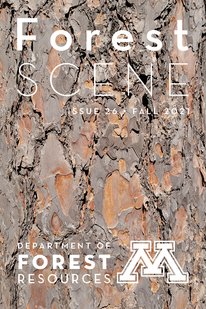
Associate Professor of Silviculture, Department of Forest Resources
Dr. Marcella Windmuller-Campione is an Associate Professor of Silviculture in the Department of Forest Resources and major coordinator for the B.S. in Forest and Natural Resource Management degree. Some of her favorite research areas are the peatland or lowland conifer forests which have extensive coverage across northern Minnesota. Two of the dominant species within peatland forests are eastern larch and black spruce; both of these species and northern white cedar are managed for multiple values. They’re not an easy habitat to get to. A layperson would recognize the less productive systems as swamps or bogs, while the more productive systems may have roads but also deep ditches that fill with water.
Some of the other forest systems in our state are more easily accessed and thus there is greater information on the ecology and management. This presents opportunities, and much of Dr. Windmuller-Campione’s research tries to fill in as many knowledge gaps as possible. “We only post pictures of the really good days in the field on Instagram, but that doesn’t capture the complexity of the system. And one of the goals of these projects is to capture those unanswered questions.”
If a forest ecosystem is an algebra problem, then her research identifies the variables in that system, observes how they interact with each other, and tests and projects how they respond to management decisions and treatments. “These forests have 60 to 120 year rotations, so we’re talking about multiple generations of foresters managing them. We’re now almost 4 or 5 years into studying some of these systems within my lab, so we’ve put in lots of plots across northern Minnesota looking at a few different things.”
One such project is a forest health collaboration with the Minnesota Invasive Terrestrial Plants and Pests Center (MITPPC) exploring the effects of native eastern spruce dwarf mistletoe to predict how an invasive mistletoe might impact jack pine. Mistletoe is a parasitic plant capable of shooting seeds at up to 60 miles per hour, which then stick to black spruce and drain its nutrients for up to 17 years before it eventually kills the tree. “We found that under lower-level mistletoe spread, we see increased species diversity due to a shift in the light levels. As mistletoe increases, we start to see mortality.”

The eastern larch beetle is a native beetle currently in a 20-year outbreak as climate change allows more generations to survive, who then kill more trees each season. “We don’t know if larch regeneration is happening or not.” Her research project with the Minnesota Department of Natural Resources and the U.S. Forest Service is trying to identify what’s happening in those ecosystems currently and then figure out if the system will regenerate naturally or if foresters need to help it with reseeding or other treatments to bring it back—if possible.
“Amy Shaunette, a graduate student working on one of our eastern larch projects, in collaboration with the Minnesota Department of Natural Resources and the U.S. Forest Service, has spent two summers in really, really hard conditions. Eastern larch are dead and dying, and bogs and everything is sinking, and there’s wood all over the place, and she’s scrambling over logs trying to figure out what’s there. It’s some of the toughest conditions a grad student has to work in. It’s slow-going, they’re difficult to access. The drought actually increased the wasp activity by a lot. It’s really hard, and she did a great job navigating it.”
“How a tree develops is completely linked to what else is in the ecosystem, and forests have been managed long before settlers showed up and started managing them. I’m hopeful that foresters will be better able to step into that conversation about why or how we manage.”

The Forest Scene newsletter is published biannually in the spring and fall, featuring stories and updates from the Department of Forest Resources. Readers can download issue 26 of Forest Scene as an interactive PDF that is fully tagged and compatible with most screen readers, or read the individual stories here in a web-based format.
